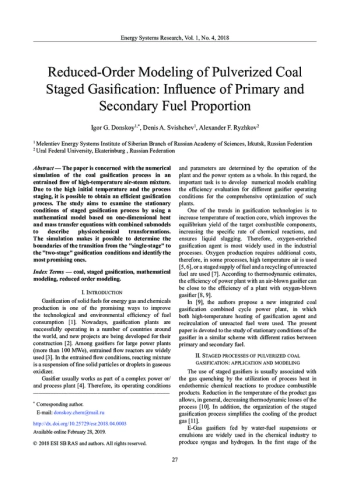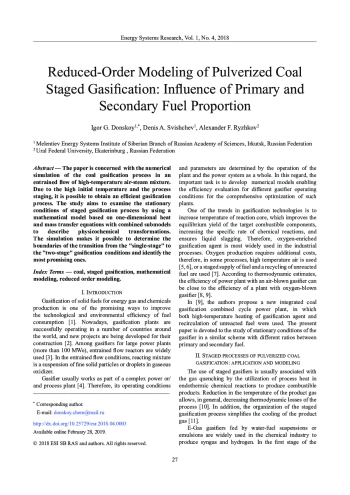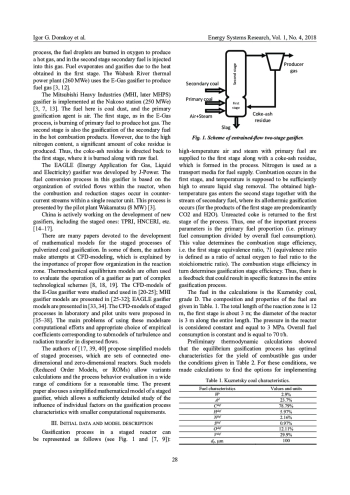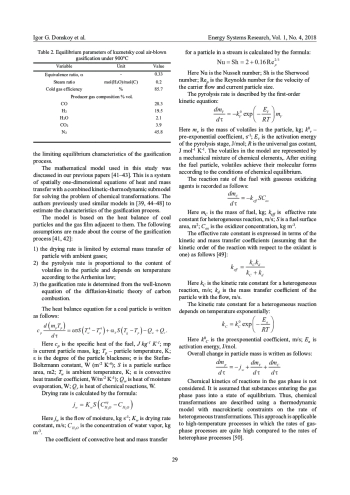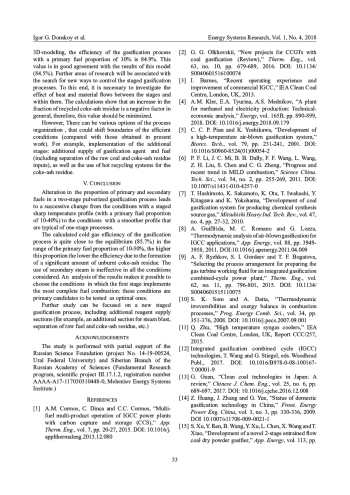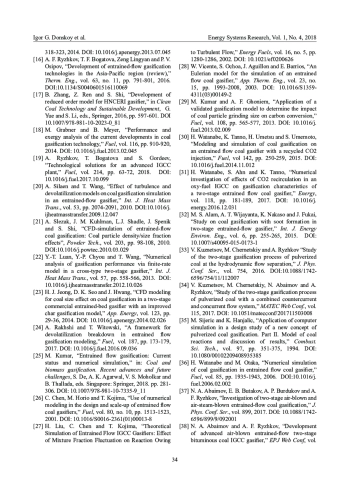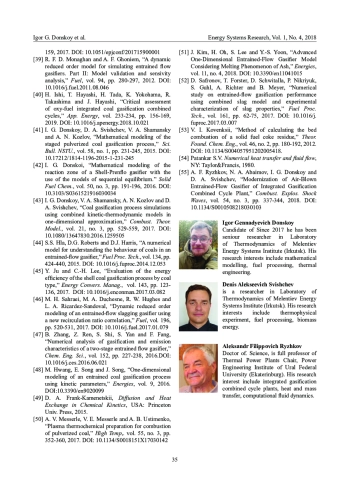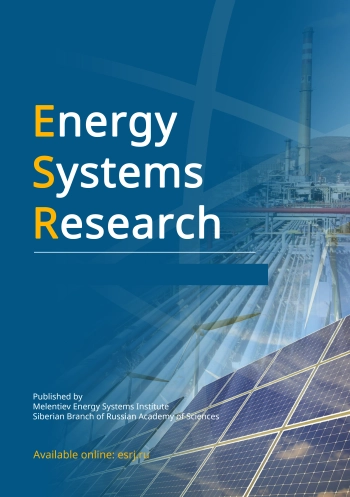The paper is concerned with the numerical simulation of the coal gasification process in an entrained flow of high-temperature air-steam mixture. Due to the high initial temperature and the process staging, it is possible to obtain an efficient gasification process. The study aims to examine the stationary conditions of staged gasification process by using a mathematical model based on one-dimensional heat and mass transfer equations with combined submodels to describe physicochemical transformations. The simulation makes it possible to determine the boundaries of the transition from the “single-stage” to the “two-stage” gasification conditions and identify the most promising ones.
Идентификаторы и классификаторы
Gasification of solid fuels for energy gas and chemicals production is one of the promising ways to improve the technological and environmental efficiency of fuel consumption [1]. Nowadays, gasification plants are successfully operating in a number of countries around the world, and new projects are being developed for their construction [2]. Among gasifiers for large power plants (more than 100 MWe), entrained flow reactors are widely used [3]. In the entrained flow conditions, reacting mixture is a suspension of fine solid particles or droplets in gaseous oxidizer.
Список литературы
1. A.M. Cormos, C. Dinca and C.C. Cormos, “Multi-fuel multi-product operation of IGCC power plants with carbon capture and storage (CCS)”, App. Therm. Eng., vol. 7, pp. 20-27, 2015. DOI: 10.1016/j.applthermaleng.2013.12.080
2. G. G. Olkhovskii, “New projects for CCGTs with coal gasification (Review)”, Therm. Eng., vol. 63, no. 10, pp. 679-689, 2016. DOI: 10.1134/S0040601516100074 EDN: XFNESB
3. I. Barnes, “Recent operating experience and improvement of commercial IGCC”, IEA Clean Coal Centre, London, UK, 2013.
4. A.M. Kler, E.A. Tyurina, A.S. Mednikov, “A plant for methanol and electricity production: Technical-economic analysis”, Energy, vol. 165B, pp. 890-899, 2018. DOI: 10.1016/j.energy.2018.09.179 EDN: UWNCAB
5. C. C. P. Pian and K. Yoshikawa, “Development of a high-temperature air-blown gasification system”, Biores. Tech., vol. 79, pp. 231-241, 2001. DOI: 10.1016/S0960-8524(01)00054-2
6. P. F. Li, J. C. Mi, B. B. Dally, F. F. Wang, L. Wang, Z. H. Liu, S. Chen and C. G. Zheng, “Progress and recent trend in MILD combustion”, Science China. Tech. Sci., vol. 54, no. 2, pp. 255-269, 2011. DOI: 10.1007/s11431-010-4257-0 EDN: ACBYUG
7. T. Hashimoto, K. Sakamoto, K. Ota, T. Iwahashi, Y. Kitagawa and K. Yokohama, “Development of coal gasification system for producing chemical synthesis source gas”, Mitsubishi Heavy Ind. Tech. Rev., vol. 47, no. 4, pp. 27-32, 2010.
8. A. Guiffrida, M. C. Romano and G. Lozza, “Thermodynamic analysis of air-blown gasification for IGCC applications”, App. Energy, vol. 88, pp. 3949-3958, 2011. DOI: 10.1016/j.apenergy.2011.04.009
9. A. F. Ryzhkov, S. I. Gordeev and T. F. Bogatova, “Selecting the process arrangement for preparing the gas turbine working fluid for an integrated gasification combined-cycle power plant”, Therm. Eng., vol. 62, no. 11, pp. 796-801, 2015. 10.1134/ S0040601515110075. DOI: 10.1134/S0040601515110075 EDN: VAFSLJ
10. S. K. Som and A. Datta, “Thermodynamic irreversibilities and exergy balance in combustion processes”, Prog. Energy Comb. Sci., vol. 34, pp. 351-376, 2008. DOI: 10.1016/j.pecs.2007.09.001
11. Q. Zhu, “High temperature syngas coolers”, IEA Clean Coal Centre, London, UK, Report CCC/257, 2015.
12. Integrated gasification combined cycle (IGCC) technologies, T. Wang and G. Stiegel, eds. Woodhead Publ., 2017. DOI: 10.1016/B978-0-08-100167-7.00001-9
13. G. Guan, “Clean coal technologies in Japan: A review”, Chinese J. Chem. Eng., vol. 25, no. 6, pp. 689-697, 2017. DOI: 10.1016/j.cjche.2016.12.008
14. Z. Huang, J. Zhang and G. Yue, “Status of domestic gasification technology in China”, Front. Energy Power Eng. China, vol. 3, no. 3, pp. 330-336, 2009. DOI: 10.1007/s11708-009-0021-1
15. S. Xu, Y. Ren, B. Wang, Y. Xu, L. Chen, X. Wang and T. Xiao, “Development of a novel 2-stage entrained flow coal dry powder gasifier”, App. Energy, vol. 113, pp. 318-323, 2014. DOI: 10.1016/j.apenergy.2013.07.045
16. A. F. Ryzhkov, T. F. Bogatova, Zeng Lingyan and P. V. Osipov, “Development of entrained-flow gasification technologies in the Asia-Pacific region (review)”, Therm. Eng., vol. 63, no. 11, pp. 791-801, 2016. DOI: 10.1134/S0040601516110069 EDN: XFLEUL
17. B. Zhang, Z. Ren and S. Shi, “Development of reduced order model for HNCERI gasifier”, in Clean Coal Technology and Sustainable Development, G. Yue and S. Li, eds., Springer, 2016, pp. 597-601. DOI: 10.1007/978-981-10-2023-0_81
18. M. Grabner and B. Meyer, “Performance and exergy analysis of the current developments in coal gasification technology”, Fuel, vol. 116, pp. 910-920, 2014. DOI: 10.1016/j.fuel.2013.02.045
19. A. Ryzhkov, T. Bogatova and S. Gordeev, “Technological solutions for an advanced IGCC plant”, Fuel, vol. 214, pp. 63-72, 2018. DOI: 10.1016/j.fuel.2017.10.099 EDN: XNTMLJ
20. A. Silaen and T. Wang, “Effect of turbulence and devolatilization models on coal gasification simulation in an entrained-flow gasifier”, Int. J. Heat Mass Trans., vol. 53, pp. 2074-2091, 2010. DOI: 10.1016/j.ijheatmasstransfer.2009.12.047
21. A. Slezak, J. M. Kuhlman, L.J. Shadle, J. Spenik and S. Shi, “CFD-simulation of entrained-flow coal gasification: Coal particle density/size fraction effects”, Powder Tech., vol. 203, pp. 98-108, 2010. DOI: 10.1016/j.powtec.2010.03.029 EDN: NWMQVZ
22. Y.-T. Luan, Y.-P. Chyou and T. Wang, “Numerical analysis of gasification performance via finite-rate model in a cross-type twostage gasifier”, Int. J. Heat Mass Trans., vol. 57, pp. 558-566, 2013. DOI: 10.1016/j.ijheatmasstransfer.2012.10.026
23. H. J. Jeong, D. K. Seo and J. Hwang, “CFD modeling for coal size effect on coal gasification in a two-stage commercial entrained-bed gasifier with an improved char gasification model”, App. Energy, vol. 123, pp. 29-36, 2014. 10.1016/j. apenergy.2014.02.026. DOI: 10.1016/j.apenergy.2014.02.026
24. A. Rakhshi and T. Witowski, “A framework for devolatilization breakdown in entrained flow gasification modeling”, Fuel, vol. 187, pp. 173-179, 2017. DOI: 10.1016/j.fuel.2016.09.036
25. M. Kumar, “Entrained flow gasification: Current status and numerical simulation”, in: Coal and biomass gasification. Recent advances and future challenges, S. De, A. K. Agarwal, V. S. Moholkar and B. Thallada, eds. Singapore: Springer, 2018. pp. 281-306. DOI: 10.1007/978-981-10-7335-9_11
26. C. Chen, M. Horio and T. Kojima, “Use of numerical modeling in the design and scale-up of entrained flow coal gasifiers”, Fuel, vol. 80, no. 10, pp. 1513-1523, 2001. DOI: 10.1016/S0016-2361(01)00013-8 EDN: ARDVKN
27. H. Liu, C. Chen and T. Kojima, “Theoretical Simulation of Entrained Flow IGCC Gasifiers: Effect of Mixture Fraction Fluctuation on Reaction Owing to Turbulent Flow”, Energy Fuels, vol. 16, no. 5, pp. 1280-1286, 2002. DOI: 10.1021/ef0200626
28. W. Vicente, S. Ochoa, J. Aguillon and E. Barrios, “An Eulerian model for the simulation of an entrained flow coal gasifier”, App. Therm. Eng., vol. 23, no. 15, pp. 1993-2008, 2003. DOI: 10.1016/S1359-4311(03)00149-2 EDN: MTLJOT
29. M. Kumar and A. F. Ghoniem, “Application of a validated gasification model to determine the impact of coal particle grinding size on carbon conversion”, Fuel, vol. 108, pp. 565-577, 2013. DOI: 10.1016/j.fuel.2013.02.009
30. H. Watanabe, K. Tanno, H. Umetsu and S. Umemoto, “Modeling and simulation of coal gasification on an entrained flow coal gasifier with a recycled CO2 injection”, Fuel, vol 142, pp. 250-259, 2015. DOI: 10.1016/j.fuel.2014.11.012
31. H. Watanabe, S. Ahn and K. Tanno, “Numerical investigation of effects of CO2 recirculation in an oxy-fuel IGCC on gasification characteristics of a two-stage entrained flow coal gasifier”, Energy, vol. 118, pp. 181-189, 2017. 10.1016/j. energy.2016.12.031. DOI: 10.1016/j.energy.2016.12.031
32. M. S. Alam, A. T. Wijayanta, K. Nakaso and J. Fukai, “Study on coal gasification with soot formation in two-stage entrainedflow gasifier”, Int. J. Energy Environ. Eng., vol. 6, pp. 255-265, 2015. DOI: 10.1007/s40095-015-0173-1
33. V. Kuznetsov, M. Chernetskiy and A. Ryzhkov “Study of the two-stage gasification process of pulverized coal at the hydrodynamic flow separation”, J. Phys. Conf. Ser., vol. 754, 2016. DOI: 10.1088/1742-6596/754/11/112007 EDN: XZTELR
34. V. Kuznetsov, M. Chernetskiy, N. Abaimov and A. Ryzhkov, “Study of the two-stage gasification process of pulverized coal with a combined countercurrent and concurrent flow system”, MATEC Web Conf., vol. 115, 2017. 10.1051/ matecconf/201711503008. DOI: 10.1051/matecconf/201711503008 EDN: UXQDLN
35. M. Sijeric and K. Hanjalic, “Application of computer simulation in a design study of a new concept of pulverized coal gasification. Part II. Model of coal reactions and discussion of results”, Combust. Sci. Tech., vol. 97, pp. 351-375, 1994. DOI: 10.1080/00102209408935385
36. H. Watanabe and M. Otaka, “Numerical simulation of coal gasification in entrained flow coal gasifier”, Fuel, vol. 85, pp. 1935- 1943, 2006. DOI: 10.1016/j.fuel.2006.02.002
37. N. A. Abaimov, E. B. Butakov, A. P. Burdukov and A. F. Ryzhkov, “Investigation of two-stage air-blown and air-steam-blown entrained-flow coal gasification”, J. Phys. Conf. Ser., vol. 899, 2017. DOI: 10.1088/1742-6596/899/9/092001 EDN: XNGZWM
38. N. A. Abaimov and A. F. Ryzhkov, “Development of advanced air-blown entrained-flow two-stage bituminous coal IGCC gasifier”, EPJ Web Conf, vol. 159, 2017. DOI: 10.1051/epjconf/201715900001 EDN: ZNAEKH
39. R. F. D. Monaghan and A. F. Ghoniem, “A dynamic reduced order model for simulating entrained flow gasifiers. Part II: Model validation and sensivity analysis”, Fuel, vol. 94, pp. 280-297, 2012. DOI: 10.1016/j.fuel.2011.08.046
40. H. Ishi, T. Hayashi, H. Tada, K. Yokohama, R. Takashima and J. Hayashi, “Critical assessment of oxy-fuel integrated coal gasification combined cycles”, App. Energy, vol. 233-234, pp. 156-169, 2019. DOI: 10.1016/j.apenergy.2018.10.021
41. I. G. Donskoy, D. A. Svishchev, V. A. Shamansky and A. N. Kozlov, “Mathematical modeling of the staged pulverized coal gasification process”, Sci. Bull. NSTU., vol. 58, no. 1, pp. 231-245, 2015. DOI: 10.17212/1814-1196-2015-1-231-245 EDN: TZGXPV
42. I. G. Donskoi, “Mathematical modeling of the reaction zone of a Shell-Prenflo gasifier with the use of the models of sequential equilibrium”. Solid Fuel Chem., vol. 50, no. 3, pp. 191-196, 2016. DOI: 10.3103/S0361521916030034 EDN: DKKUOV
43. I. G. Donskoy, V. A. Shamansky, A. N. Kozlov and D. A. Svishchev, “Coal gasification process simulations using combined kinetic-thermodynamic models in one-dimensional approximation”, Combust. Theor. Model., vol. 21, no. 3, pp. 529-559, 2017. DOI: 10.1080/13647830.2016.1259505 EDN: YFPFEL
44. S.S. Hla, D.G. Roberts and D.J. Harris, “A numerical model for understanding the behaviour of coals in an entrained-flow gasifier”, Fuel Proc. Tech., vol. 134, pp. 424-440, 2015. DOI: 10.1016/j.fuproc.2014.12.053
45. Y. Ju and C.-H. Lee, “Evaluation of the energy efficiency of the shell coal gasification process by coal type”, Energy Convers. Manag., vol. 143, pp. 123-136, 2017. DOI: 10.1016/j.enconman.2017.03.082
46. M. H. Sahraei, M. A. Duchesne, R. W. Hughes and L. A. Ricardez-Sandoval, “Dynamic reduced order modeling of an entrained-flow slagging gasifier using a new recirculation ratio correlation”, Fuel, vol. 196, pp. 520-531, 2017. 10.1016/j. fuel.2017.01.079. DOI: 10.1016/j.fuel.2017.01.079
47. B. Zhang, Z. Ren, S. Shi, S. Yan and F. Fang, “Numerical analysis of gasification and emission characteristics of a two-stage entrained flow gasifier”, Chem. Eng. Sci., vol. 152, pp. 227-238, 2016. DOI: 10.1016/j.ces.2016.06.021 EDN: WUSCSJ
48. M. Hwang, E. Song and J. Song, “One-dimensional modeling of an entrained coal gasification process using kinetic parameters”, Energies, vol. 9, 2016. DOI: 10.3390/en9020099
49. D. A. Frank-Kamenetskii, Diffusion and Heat Exchange in Chemical Kinetics, USA: Princeton Univ. Press, 2015.
50. A. V. Messerle, V. E. Messerle and A. B. Ustimenko, “Plasma thermochemical preparation for combustion of pulverized coal”, High Temp,. vol. 55, no. 3, pp. 352-360, 2017. DOI: 10.1134/S0018151X17030142 EDN: XNDWVU
51. J. Kim, H. Oh, S. Lee and Y.-S. Yoon, “Advanced One-Dimensional Entrained-Flow Gasifier Model Considering Melting Phenomenon of Ash”, Energies, vol. 11, no. 4, 2018. DOI: 10.3390/en11041015
52. D. Safronov, T. Forster, D. Schwitalla, P. Nikriyuk, S. Guhl, A. Richter and B. Meyer, “Numerical study on entrained-flow gasification performance using combined slag model and experimental characterization of slag properties”, Fuel Proc. Tech., vol. 161, pp. 62-75, 2017. DOI: 10.1016/j.fuproc.2017.03.007
53. V. I. Kovenksii, “Method of calculating the bed combustion of a solid fuel coke residue”, Theor. Found. Chem. Eng., vol. 46, no. 2, pp. 180-192, 2012. DOI: 10.1134/S004057951202005418 EDN: XMYCJJ
54. Patankar S.V. Numerical heat transfer and fluid flow, NY: Taylor&Francis, 1980.
55. A. F. Ryzhkov, N. A. Abaimov, I. G. Donskoy and D. A. Svishchev, “Modernization of Air-Blown Entrained-Flow Gasifier of Integrated Gasification Combined Cycle Plant”, Combust. Explos. Shock Waves, vol. 54, no. 3, pp. 337-344, 2018. DOI: 10.1134/S0010508218030103
Выпуск
Другие статьи выпуска
An increase in service life of equipment and plants (objects) in electric power systems makes it more appropriate to relate the organization of a system of maintenance service and restoration of wear and tear to their technical condition. This, in turn generates the need to quantitatively estimate the indices of their individual reliability. There can be no data on failures and defects of concrete objects, therefore, in practice we often calculate generalized reliability indices. An intuitive understanding of the varied significance of varieties of attributes is reflected by classifying statistical data for some varieties of attributes. For example, they can be classified according to voltage class, design, service life, etc. At the same time, the question on the appropriateness of the statistical data classification is not considered. Initial assumptions of known methods and criteria of checking if it is expedient to classify the statistical data on failures of the electric power system objects in most cases are unacceptable, since they are not relevant to this data set. We have developed a new method and an algorithm to assess the appropriateness of the statistical data classification. Their novelty lies in the application of a fiducial approach to estimation of critical values of a sample from a set of multivariate statistical data.
The paper presents an option for determination of phase loads in the primary distribution network using the results of state estimation of the secondary distribution network that are obtained by smart meter measurements installed at the load and generator nodes. The problem of state estimation in the secondary distribution network based on measurements of the active and reactive nodal powers and voltage magnitudes rather than by the Newton method traditionally used for this purpose is solved by a method of simple iterations. Efficiency of using the proposed approach for determination of phase loads of the primary distribution network for each hour of daily curve of nodal powers is illustrated by the example of a 32-node test network.
The paper focuses on the probabilistic evaluation of oil and gas resources with the models and methods of AHP/ANP analysis. The AHP/ANP models are shown to be the particular cases of finite Markov chains, i. e. discrete random processes with Markov property. An integrated method (Markov expert logical analysis (МELA)) is proposed. The method is based on the models, methods and algorithms of Markov chains theory. This basis will stimulate the progress in research on multi-criteria decision-making problems that arise in various spheres. The paper presents different methods using MELA to allow for the uncertainty of numeric and nonnumeric data on gas reserves as methods of transformation of expert estimations into the probability distributions. Typical logical schemes are proposed for multi-criteria comparison of analogous objects, to take account of possible errors in porosity evaluation and to estimate project life.
The paper analyses the role of the Asia Pacific Region and East Asia, in particular, for both Russia and Mongolia as energy exporters. A quantitative assessment of coal, oil and natural gas markets demand of East Asia countries is made. The assessment relies on our outlook, and the outlooks of Russian and foreign organizations. The prospective directions of energy cooperation between Russia and Mongolia, which allow harnessing the resource, geographical and economic potential of the two countries and expanding energy cooperation with the other countries in East Asia, are proposed.
The paper places an emphasis on the fact that many publications on complex reliability assessment of electric power and fuel systems do not always substantiate the application of various methods. We address the “system”, “nodal”, and “estimation” approaches to assess the reliability of electric power systems, given reliable fuel supply to power plants. These approaches are accompanied by an analysis of their correspondence to the objectives and goals of the study, as well as an analysis of the validity of their application in terms of the obtained result accuracy, research time, complexity of search for and preparation of the input data and forms of their representation in a model. All the approaches were tested in case studies. The nodal and system approaches were tested on a conventional power system, while the estimation approach was tested on design diagrams of the gas and electric power systems of the Northwestern Federal District of the Russian Federation
The paper presents the background of creation and development of Mongolia’s electric power industry and its current state. Despite considerable energy resources, the country suffers from electric power shortage that is covered by electricity supplied from Russia and China. The expected considerable power consumption growth can be met by doubling generating capacities, enhancing electrical networks and by interconnecting the five existing electric power systems (EPSs) into an Integrated Power System (NPS) of Mongolia as a future component of the Northeast Asian Super Grid. To accomplish these tasks, we propose a number of conceptual structural and technological models for the development of Mongolian electric power systems that can form a basis for the future Integrated Power System of Mongolia.
The progressing distribution of the electricity supply necessitates redesigning the mechanism for providing ancillary services particularly by the distribution grid. Methods of voltage regulation and congestion management particularly have to satisfy new standards since, although the development of renewables is increasing the number of resources with an impact, these resources’ individual contribution is comparatively slight. Taking the state-of-the-art and the basic regulatory conditions in Germany as a point of departure, this paper analyzes the requirements for algorithms and communication systems that provide distributed support to distribution grid operation. A novel mathematical method that prevents voltage range deviations and feeder overloads based on sensitivities is presented and validated in simulations by a case study. An analysis of the communications systems for monitoring and control technologies for distributed energy resources, including the available communication channels, serves as the basis for an evaluation of the suitability of current control mechanisms in the future. The findings of a live field test in a real 110 kV distribution grid corroborate the necessity for coordinated grid support by distributed energy resources and demonstrate the limits of current methods.
Статистика статьи
Статистика просмотров за 2025 год.
Издательство
- Издательство
- ИСЭМ СО РАН
- Регион
- Россия, Иркутск
- Почтовый адрес
- 664033, Иркутская область, г. Иркутск, ул. Лермонтова, д. 130.
- Юр. адрес
- 664033, Иркутская область, г. Иркутск, ул. Лермонтова, д. 130.
- ФИО
- Стенников Валерий Алексеевич (Руководитель)
- E-mail адрес
- info@isem.irk.ru
- Контактный телефон
- +7 (395) 2500646
- Сайт
- https:/isem.irk.ru
